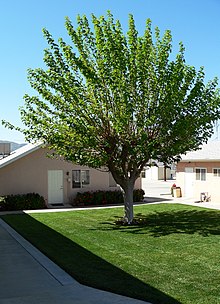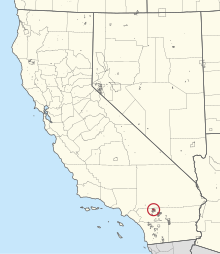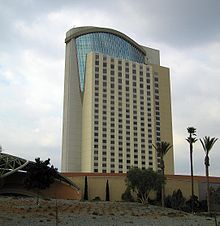Morongo Band of Mission Indians
 Moravian Church on the Morongo Reservation | |
| Total population | |
|---|---|
| 996[1] | |
| Regions with significant populations | |
| United States (California) | |
| Languages | |
| English, Pass Cahuilla, and Serrano.[2] | |
| Religion | |
| traditional tribal religion, Christianity (Roman Catholicism)[3] | |
| Related ethnic groups | |
| other Cahuilla, Cupeño, and Serrano peoples |
The Morongo Band of Mission Indians is a federally recognized tribe in California, United States. The main tribal groups are Cahuilla and Serrano. Tribal members also include Cupeño, Luiseño, and Chemehuevi Indians.[4] Although many tribes in California are known as Mission Indians, some, such as those at Morongo, were never a part of the Spanish Missions in California.
The Morongo Reservation is located in Riverside County, California in the San Gorgonio Pass. Established as the Portrero Reservation by executive order in 1876 under President Ulysses S. Grant, and called Malki by the Native Americans, the Morongo name was adopted by 1908 when the land was patented to the Morongo Band of Mission Indians.[5] The tribe has developed a large casino and hotel resort at Cabazon to generate revenues for tribal welfare and economic development.[1]
Reservation
[edit]
The Morongo Reservation (33°57′10″N 116°48′28″W / 33.95278°N 116.80778°W) is located at the base of the San Gorgonio and San Jacinto Mountains. It is more than 35,000 acres (14,000 ha) in size. On May 15, 1876, President Ulysses S. Grant established this and eight other reservations in the area by executive order.[6] Approximately 954 of the 996 enrolled tribal members live on the reservation.[1]
The name Morongo is derived from the Serrano clan, Maarrenga. The first official "Captain" of Potrero Ajenio (aka San Gorgonio Agency), recognized by the Bureau of Indian Affairs, was the hereditary leader of the Maarrenga, known to Americans by his English name, John Morongo. As time went on, the Bureau began to refer to the tribe as the Morongo Band of Mission Indians.
Government
[edit]The Morongo Band of Mission Indians is headquartered in Banning, California. They are governed by a democratically elected tribal council. Their current administration is as follows:
- Charles Martin, Chairman
- James Siva, Vice-Chairman
- Mary Ann Andreas, Councilmember
- Jeanette Burns, Councilmember
- Teresa Sanchez, Councilmember
- Brian Lugo, Councilmember
- Theresa Mathews, Councilmember
Education
[edit]The reservation runs its own education services, including independent college prep high schools and pre-K through 8th grade schools. The reservation is planning to add a high school, and natives not living directly on the reservation are zoned to the Banning Unified School District.[7]
Languages
[edit]Cahuilla and Serrano are Takic languages, part of the Uto-Aztecan language family. The main aboriginal group of the San Gorgonio Pass are Pass Cahuilla, who call the area Maalki. The Serrano, who had traditionally intermarried with the Pass Cahuilla, and who have lived in the area since well before the inception of the reservation, call the area Maarrkinga'.
The Cahuilla and Serrano languages are technically considered to be extinct as they are no longer spoken at home, and children are no longer learning them as primary languages.[8] Joe Saubel, a Morongo tribal member and the last pure speaker of Pass Cahuilla, died in 2008. The last pure speaker of Serrano was an enrolled member at Morongo, Ms. Dorothy Ramon, who died in 2002. Recent generations have found a renewed interest in their native languages, however. Many families are working to have their children educated to speak Pass Cahuilla and/or Serrano.[9]
In 2012, the Limu Project announced that it had successfully reconstructed Pass Cahuilla, and it is offering an online course.[10] The project also offers online courses in Maarrenga' (Morongo Band "Serrano" dialect) and Yuhaviat (Santos Manuel Band "Serrano" dialect).[11]
Programs, economic and cultural development
[edit]Gaming
[edit]
The tribe opened a small bingo hall in 1983, which became the foundation of what is now one of the oldest Native gaming enterprises in California. The government of Riverside County, California, attempted to shut down the bingo hall. The tribe joined with the Cabazon Band of Mission Indians in suing the local government, a case that eventually was decided by the U.S. Supreme Court. On February 25, 1987, the court upheld the right of sovereign Indian tribes to operate gaming enterprises on their reservations.[12]
The Morongo Casino, Resort & Spa was opened in 2004 in Cabazon, California.[6] It is open seven days a week, 24 hours a day. The hotel has 310 rooms. Several restaurants and bars are part of the complex: Desert Orchid: contemporary Asian cuisine, Potrero Canyon Buffet, Cielo: Pacific Coast Steak and Seafood Restaurant, Serrano, Sunset Bar and Grill, a food court, Mystique Lounge, and the Pit Bar. The club, 360, is open on weekends.[13]
Water
[edit]The tribe participated in development of a water bottling plant on the reservation. It is operated by Nestle Waters North America Inc., which leases the property from the tribe. The plant bottles Arrowhead spring water, as well as purified water sold under the brand Nestle Pure Life. In his 2010 book, Bottled and Sold: The Story Behind Our Obsession with Bottled Water, author Peter H. Gleick said the plant was producing more than 1 billion bottles of Arrowhead spring water per year.[14]
Cultural
[edit]The Malki Museum on the Morongo Reservation is open to the public. It maintains the Malki Museum Press, which publishes the Journal of California and Great Basin Anthropology and scholarly books on Native American culture. The reservation is also home to the Limu Project, a tribal community-based nonprofit organization that helps families preserve knowledge of their indigenous languages, history, and cultural traditions.[15]
Churches
[edit]Two churches are on the Morongo Reservation. They are the Protestant Morongo Moravian Church and the Catholic St. Mary's Mission, maintained by the Saint Kateri Tekakwitha Catholic Community.[16][17]
Notable tribal members
[edit]- Marigold Linton (b. 1936), psychologist, educator, and author
References
[edit]Bibliography
[edit]- Eargle, Jr., Dolan H. California Indian Country: The Land and the People. San Francisco: Tree Company Press, 1992. ISBN 0-937401-20-X.
- Gunther, Jane Davies. Riverside County, California, Place Names; Their Origins and Their Stories, Riverside, CA, 1984. LOC catalog number: 84-72920.
- Hinton, Leanne. Flutes of Fire: Essays on California Indian Languages. Berkeley: Heyday Books, 1994. ISBN 0-930588-62-2
- Pritzker, Barry M. A Native American Encyclopedia: History, Culture, and Peoples. Oxford: Oxford University Press, 2000. ISBN 978-0-19-513877-1.
Citations and notes
[edit]- ^ a b c California Indians and Their Reservations: M. San Diego State University Library and Information Access. 2010 (retrieved 18 May 2010) Archived January 10, 2010, at the Wayback Machine
- ^ Eargle, 111
- ^ Pritzker, 120
- ^ Pritzker 24, 120
- ^ Gunther, pp 334-335.
- ^ a b "California v. Cabazon" Mary Ann Irwin. (retrieved 5 September 2010)
- ^ "Education Services". Morongo Band of Mission Indians. Retrieved 23 November 2024.
- ^ Hinton, 28, 32
- ^ Blankenship, Arkamez. "Awakening Wanikik". The Limu Project. Retrieved 6 June 2012.
- ^ "Awakening Wanikik". The Limu Project. 2012-02-11. Retrieved 2013-05-08.
- ^ "iLearn Course Portal – iLearn. Wanipiyapa (Wanikik, Palm Springs Cahuilla, Pass Cahuilla)". The Limu Project. Retrieved 2013-05-08.
- ^ California v. Cabazon Band, 480 U.S. 202 (1987).
- ^ "Morongo Casino Resort Spa." 500 Nations. (retrieved 18 May 2010)
- ^ James, Ian (July 12, 2014). "Nestle, Arrowhead tapping water from Morongo reservation". Desert Sun. Retrieved 2015-06-15.
- ^ Limu Project
- ^ "Saint Kateri Tekakwitha Catholic Community: St. Mary's Mission". Archived from the original on 2013-12-31. Retrieved 2014-01-05.
- ^ Moravian Church: Western District. U.S. Geological Survey Geographic Names Information System: Morongo Moravian Church: 33°57′21″N 116°49′41″W / 33.955848°N 116.828075°W
Further reading
[edit]- James, Harry Clebourne (1968) [1960]. The Cahuilla Indians. Morongo Reservation: Malki Museum (Westernlore Press). ASIN B0007HDH7E. LCCN 60010491. OCLC 254156323. LCC E99.K27 J3 ASIN B0007EJ4OM
- Mager, Elisabeth (2017). "Ethnic Consciousness in Cultural Survival: The Morongo Band of Mission Indians and the Kickapoo Traditional Tribe of Texas". American Indian Culture and Research Journal. 41 (1): 47–72. doi:10.17953/aicrj.41.1.mager.
External links
[edit]- Morongo Band of Mission Indians, official website
- Malki Museum, tribal museum at Morongo Reservation, Banning California
- The Limu Project, nonprofit organization providing language and cultural revitalization
- U.S. Geological Survey Geographic Names Information System: Morongo Reservation

